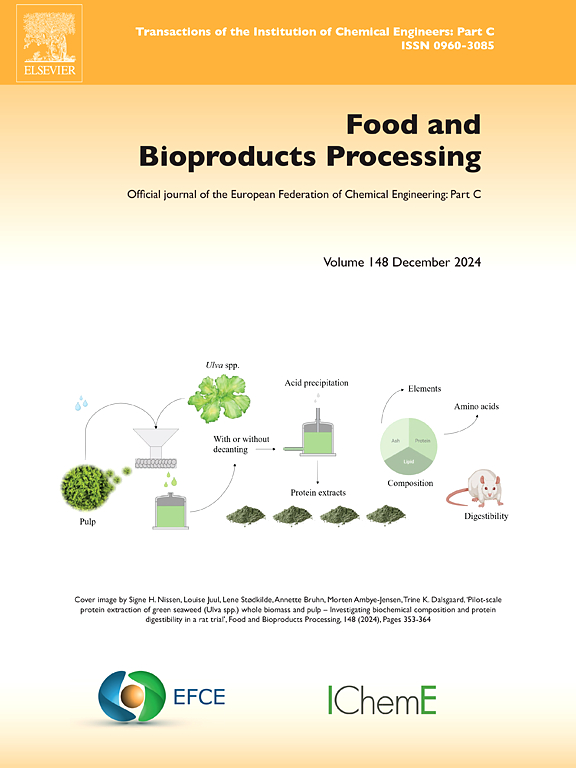百香果皮中生物活性物质的提取和浓缩方法的经济评价
IF 3.4
2区 农林科学
Q2 BIOTECHNOLOGY & APPLIED MICROBIOLOGY
引用次数: 0
摘要
本研究评估了超声辅助加压液体萃取(uapple)和纳滤(NF)技术在不同生产规模下从百香果皮中提取和浓缩生物活性物质的经济可行性。此外,分析了主要成本组成部分和盈利指标,以评估其工业实施的潜力。效益进行了分析使用SuperPro Designer 9.0®来模拟三个生产规模:2 ×30 L 2 × L, 300和2 ×3000 L。该研究评估了主要的经济指标,包括制造成本(COM)、总资本投资(TCI)、毛利率(GM)、投资回报率(ROI)、净现值(NPV)和投资回收期。进行敏感性分析以评估提取物销售价格对盈利能力的影响。由于固定成本的稀释和生产力的提高,扩大规模显著降低了COM。原材料(CRM)和公用事业(CUT)成本是主要的成本驱动因素,而固定资本投资(FCI)和操作劳动力(COL)在较大规模上的相对影响较小。由于DK和DL膜具有较高的生物活性化合物回收率,因此其COM最低。敏感性分析表明,盈利能力高度依赖于销售价格,在最有利的情况下,投资回收期在两年以下。uapple - nf工艺在工业规模上具有很强的经济可行性,具有显著的成本降低和良好的盈利指标。这些发现支持其作为生物活性化合物提取的可持续替代品的应用。未来的研究应探索生物炼制模式中的工艺整合,以提高可持续性和资源效率。本文章由计算机程序翻译,如有差异,请以英文原文为准。
Economic evaluation of a promising strategy for the extraction and concentration of bioactive compounds from passion fruit rinds
This work evaluated the economic feasibility of integrating Ultrasound-Assisted Pressurized Liquid Extraction (UAPLE) and Nanofiltration (NF) for the extraction and concentration of bioactive compounds from passion fruit rinds at different production scales. Furthermore, it analyzed the main cost components and profitability indicators to assess its potential for industrial implementation. A techno-economic analysis was performed using SuperPro Designer 9.0® to simulate three production scales: 2 × 30 L, 2 × 300 L, and 2 × 3000 L. The study evaluated key economic indicators, including Cost of Manufacturing (COM), Total Capital Investment (TCI), Gross Margin (GM), Return on Investment (ROI), Net Present Value (NPV), and Payback time. Sensitivity analysis was conducted to assess the impact of extract selling prices on profitability. Scaling up significantly reduced COM due to fixed cost dilution and increased productivity. Raw material (CRM) and utility (CUT) costs were the primary cost drivers, while fixed capital investment (FCI) and operational labor (COL) had lower relative impact at larger scales. The DK and DL membranes provided the lowest COM due to their higher recovery efficiency of bioactive compounds. Sensitivity analysis indicated that profitability is highly dependent on selling price, with payback time under two years in the most favorable scenarios. The UAPLE-NF process proved to have strong economic feasibility at an industrial scale, with significant cost reductions and promising profitability indicators. These findings support its application as a sustainable alternative for bioactive compound extraction. Future research should explore process integration within biorefinery models to enhance sustainability and resource efficiency.
求助全文
通过发布文献求助,成功后即可免费获取论文全文。
去求助
来源期刊

Food and Bioproducts Processing
工程技术-工程:化工
CiteScore
9.70
自引率
4.30%
发文量
115
审稿时长
24 days
期刊介绍:
Official Journal of the European Federation of Chemical Engineering:
Part C
FBP aims to be the principal international journal for publication of high quality, original papers in the branches of engineering and science dedicated to the safe processing of biological products. It is the only journal to exploit the synergy between biotechnology, bioprocessing and food engineering.
Papers showing how research results can be used in engineering design, and accounts of experimental or theoretical research work bringing new perspectives to established principles, highlighting unsolved problems or indicating directions for future research, are particularly welcome. Contributions that deal with new developments in equipment or processes and that can be given quantitative expression are encouraged. The journal is especially interested in papers that extend the boundaries of food and bioproducts processing.
The journal has a strong emphasis on the interface between engineering and food or bioproducts. Papers that are not likely to be published are those:
• Primarily concerned with food formulation
• That use experimental design techniques to obtain response surfaces but gain little insight from them
• That are empirical and ignore established mechanistic models, e.g., empirical drying curves
• That are primarily concerned about sensory evaluation and colour
• Concern the extraction, encapsulation and/or antioxidant activity of a specific biological material without providing insight that could be applied to a similar but different material,
• Containing only chemical analyses of biological materials.
 求助内容:
求助内容: 应助结果提醒方式:
应助结果提醒方式:


